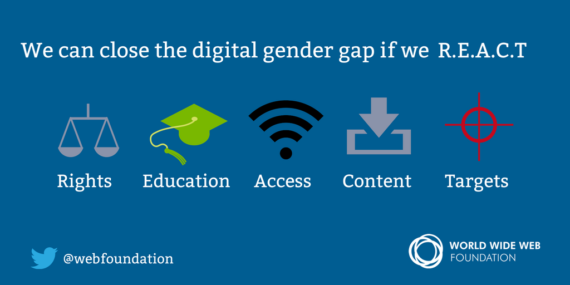This post was written by Nanjira Sambuli, the Web Foundation’s Digital Equality Advocacy Manager.
“If we want a web for all, it has to be a public good and a human right”
Last week I spoke at MozFest on the topic of digital equality. The event was dedicated to building a healthy internet, so I felt the need to take stock of the current situation: access to the web remains unequal. Why? Because of policy failure, women are 50% less likely to access the internet than men, and 30-50% less likely to use it for personal empowerment, according to our Women’s Rights Online Digital Gender Gap Research (2015). As it stands, the web is currently not accessible by everyone. We need to do better.
No country will achieve universal, healthy internet access without tackling the digital gender divide. While connectivity is not a one-size-fits-all solution, it’s imperative that women are included in, and empowered by, the digital revolution. The Women’s Rights Online network produced the REACT framework for this reason.
Countries with an ICT or broadband policy that clearly outlines strategies and targets for increasing internet penetration tend to have higher rates of broadband adoption and lower broadband prices (as the World Bank and A4AI research has shown). For example, Costa Rica’s Universal Service and Access Fund provides a subsidy to low-income households to purchase fixed internet service and a computer. Approximately 95% of the households that qualify for a subsidy under this programme are headed by women (A4AI, 2017). This way, they are able to address the finding that relative cost to connect was higher for female-headed households (and highest for single parent, female-headed households).
When I spoke at MozFest, I was encouraged by the appetite in the room to do better and to REACT. We all have a role to play — especially governments and public policy experts.

Governments must be involved right from the get-go, particularly because the existence of the gender digital gap is fundamentally a result of policy failure. In order to fix it, it will take sound government policies, and more importantly, it will require that governments integrate gender considerations in all policy, planning, programming and monitoring stages.
Laudable efforts to promote digital inclusion have emerged from civil society organisations and NGOs, as well as from the private sector. For us to measure progress and truly connect the unconnected, we must work to align these efforts with sound public policies, and to make open and public the impacts and shortcomings of our interventions. We need to consider what happens when our resources or interests are diverted; who takes over, especially if these show potential for scale? Public resources can and should be invested in this space to maintain the good work we start.
Reclaiming the policy space, simply put, is to reclaim a solid foundation for a healthy internet.
For more updates on the Women’s Rights Online network and other Web Foundation programmes, follow us on Twitter at @webfoundation and sign up to receive our email newsletters.
